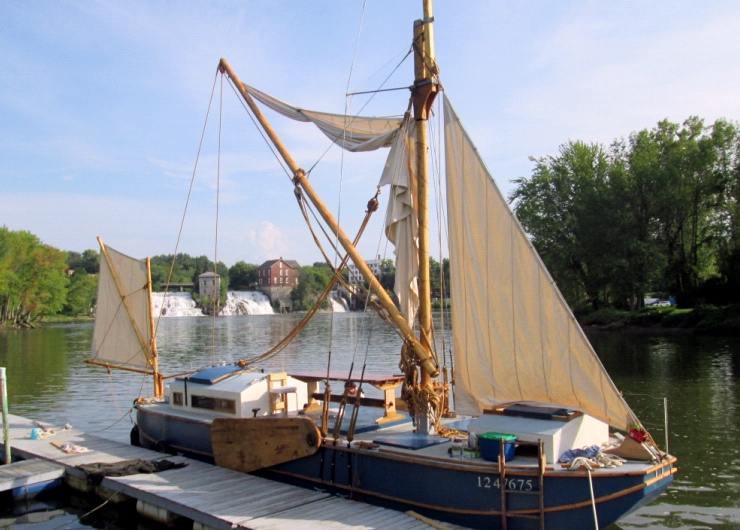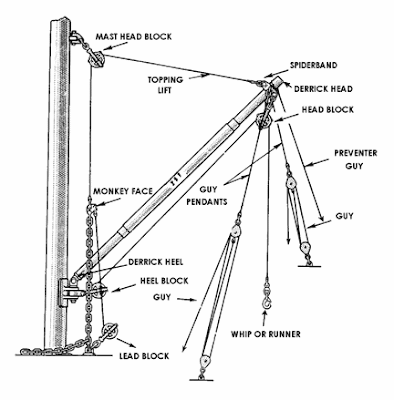 |
| CERES unloading, using her sprit as a Cargo Boom. Note the 'universal joint' is a simple snotter. |
A-haw haw haw haw
Hmmm hmmm hmmm hmmm...
-- From Boom Boom by Johnny Lee Hooker
Cargo Booms for Cruisers
A Cargo Boom is a durn handy thing.
Boarding or off-loading cargo (including groceries, luggage, tools, flotsam, what-have-you), a dinghy, an MOB, a pet. Raising a mast, a large hatch, an anchor. Heeling the hull to lift clear of that rock ledge you clipped...
A Cargo Boom is a durn handy thing!
The jargon of cargo handling is extensive and not always perfectly standardized. Here, I'm going to use terms as I've heard them used in my area. For those who care, there are many fine hairs to split.
 |
| A fully rigged Cargo Boom |
Boom Derrick
The derrick (referring to the whole setup) pictured above is very common, though on small boats, seldom so thoroughly rigged. Essentially, it has a universal joint more or less fixing its derrick/boom heel to a mast, a topping lift to control lift aka hoist (vertical lift/lower) and guys to control swing (horizontal rotation).
A sailboat already has a mast, halyard (generally with multiple purchase) and likely a boom (and/or spinnaker pole). Thoughtfully rigged, the halyard can be transferred to the lift point of the boom (if not already so rigged) and guys added, and shazzam... you've got your cargo boom! Best yet, this kind needs no additional stowage when not in use.
Once set up, the boom can be more or less short and horizontal (preferred for amateurs) or more or less long and vertical (preferred by professionals). In both cases, the topping lift should be at near right angles to the boom.
In the short, horizontal case, the topping lift should be at an acute (sharp) angle to the mast (which then supports the load mostly in compression. The boom is only holding the load away from the mast, in this case, and is under much less stress than if it were near vertical.
Consider a halyard attachment which is easy to shift, with enough extra length to drop the boom end to deck level. Consider a universal joint that can handle the full range of potential boom movement. Consider bungee lines to gather rigging (such as lazy jacks) that go slack during boom operations. Consider supplemental backstays to support the masthead (low stretch line or wire in all stays... nylon is stretchy and can be dangerous!).
Stowing a dedicated cargo boom can be inconvenient. Rigs with spars set on one side of the mast have a section along the mast side opposite the spars that will never be swept, called the chimney. A boom may be stored vertically in this location. Consider using the boom as a side rail (like a lifeline) when not in use.
 |
| The pole isn't labelled... it's lower center and angled... the load is hanging from it. |
Gin Pole
A gin pole is simply a near vertical boom with no mast.
Essentially, the heel is securely fixed to the deck, and the head inclined over some useful hoist point.
It can be rigged to hoist and swing around that point, but operation is complicated. More commonly, it is guyed (stayed) in one position, and lifting tackle used to hoist the load.
This type is less useful for cargo, and is generally improvised for raising a mast.

A-Frame
An A-frame derrick is a spread pair of poles lashed at the apex, and working in compression. Tackle hoists from the apex, and the fore and rear (aft) guy swing a load up and along a line perpendicular to that of the legs.
On board, this can be set up on the sheer, and cargo hoisted, then swung inboard.
Be aware that the guys can develop immense tension loads if their lead becomes too acute, and the threshold is reached and surpassed in surprisingly short order. If overloaded, something is likely to give - a guy or your sheer structures, most likely - and the A-frame can whop flat like a mouse-trap. Ya feel me, Mouse?
Be sure to limit the swing to short hops, keeping the A-frame near vertical at all times. Consider raising the guy anchors to improve their lead to the apex (closer to right angles).
Downside of A-frames is that they're a lot to stow. On the other hand, they work well at barge ends. Many rigs can be improved by A-frame masts, so it can pay its way between jobs.
I sometimes dream of an aft A-frame, flying a double stays'l rig on roller furlers. Whatta toy!
Cautions
Keep in mind that, even with relatively light loads, some wicked forces can develop.
As cruisers, our setup is likely to be DIY and... well... funky. Do familiarize yourself with forces involved and safety procedures, and follow them scrupulously! Do not pass under a load or allow anyone else to do so. Move slowly, with good communication among all present. Keep lift/lower and swing in/out operations separate.
Consider familiarizing yourself with vector diagrams to help assess loading. Consider which forces are acting in compression, and which in tension. Consider keeping your boom either short and close in (when used horizontally), or long and close in (when used vertically). Consider hoisting only modest loads.
Cultivate a state of healthy paranoia!

